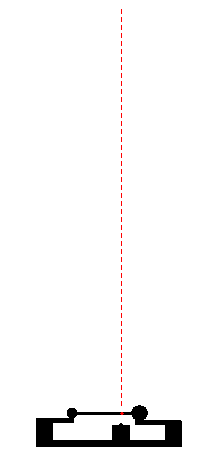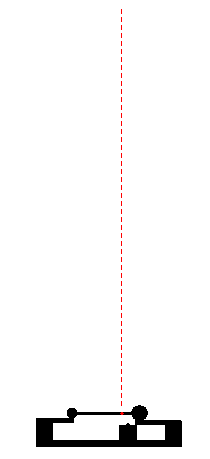 Secondary
Primary
Home
☰
Secondary
Primary
Home
☰
The Centre of Mass of a body or a system of particles is defined as a single point at which the whole mass of the body or system is imagined to be concentrated and all the applied forces act at that point.
Source: City Collegiate, URL: http://www.citycollegiate.com/centre_of_mass.htm


The movie at left shows an object which is more massive at one end than the other, so that the Centre of Mass is located towards the larger (more massive) end. When the object is struck at the Centre of Mass the object translates (moves in a straight line) but does not rotate about the Centre of Mass.
The movie at the right shows an object that is struck to the right of the COM. Now the objects translates and rotates counterclockwise about the COM. Notice that the COM moves in the same straight line as it did when the impact was at the COM. This illustrates that the COM is the single point which characterizes the translational motion of the object.
If a net force is applied to the Centre of Mass the resulting motion will be translation (the object will not rotate).
Source: Acoustics and Vibration Animations, ©2004-2011, URL: https://www.acs.psu.edu/drussell/demos/com/com-a.html
Centre of Mass
meriSTEM Mechanics module explores linear motion and force including velocity, acceleration, forces, vectors, free body diagrams, Newton's laws, momentum and conservation of energy.
Source: ClickView, 2020, Rated G, Duration 1:53, URL: https://online.clickview.com.au/exchange/videos/22862507/1-5-centre-of-mass
When all the forces that act upon an object are balanced, then the object is said to be in a state of equilibrium.
Source: the Physics Classroom, URL: https://www.physicsclassroom.com/class/vectors/Lesson-3/Equilibrium-and-Statics
Equilibrium
Source: EBSCO Explora, 2020, URL: https://search.ebscohost.com/login.aspx?direct=true&AuthType=ip,sso&db=tol&AN=89316994&custid=ns126408
Static equilibrium refers to the physical state in which a system’s components are at rest and the net force is zero through the system.
Source: Toppr, URL: https://www.toppr.com/guides/physics/mechanics/static-equilibrium-definition-and-equation/
An object is in translational equilibrium (its momentum is constant) if the sum of the forces acting on it is zero.
Source: URL: https://www.physics.utoronto.ca
Source: Translational Equilibrium PP, URL: https://www.stcharlesprep.org/01_parents/vandermeer
Torque is "twisting or turning ability" of a force that can:
• change the angular velocity of an object (i.e. speed up or slow down rotation)
• cause a twisting or bending distortion of an object
Source: http://www.physics.usyd.edu.au/~helenj/Mechanics/PDF/mechanics08.pdf
An object is in rotational equilibirum (its angular momentum is constant) if the sum of the torques acting on it is zero.
Source: URL: https://www.physics.utoronto.ca
The center of gravity (CG) of an object is the point at which weight is evenly dispersed and all sides are in balance.
Source: Study.com, 2016, URL: https://study.com/academy/lesson/what-is-center-of-gravity-definition-equation-examples.html
Centre of Gravity and Stability
The centre of gravity of an object is the point where its entire weight appears to act, and its stability is its ability to maintain its original position. Objects with lower centres of gravity, for example racing cars, are more stable. Hence, a racing car can corner rapidly without turning over.
Source: ClickView, Sterling Pixels, 2015, Rated E, Duration 5:19, URL: https://online.clickview.com.au/libraries/videos/31063281/centre-of-gravity-and-stability
Stability is a measure of how likely it is for an object to topple over when pushed or moved.
Source: BBC Bitesize, URL: https://www.bbc.co.uk/bitesize/guides/zkwxgwx/revision/6#:~:text=Stability
Source: BBC Bitesize, URL: https://www.bbc.co.uk/bitesize/guides/zkwxgwx/revision/6